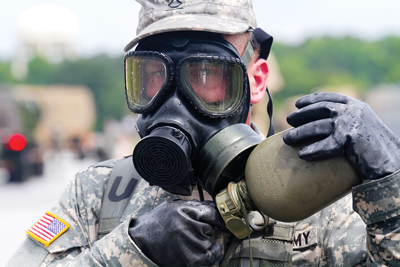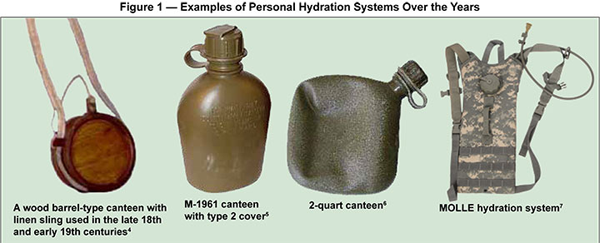Aerial interdiction, Afghanistan, Operation Shrimps Net
by John R. Kennedy and Jeffrey S. Pacuska

A South Carolina Army National Guard Soldier drinks water through his protective mask during a decontamination exercise in Varnville, S.C., on 19 May 2013. Photo by SGT Erica Knight
You may talk o’ gin and beer
When you’re quartered safe out ‘ere,
An’ you’re sent to penny-fights an’ Aldershot it;
But when it comes to slaughter
You will do your work on water,
An’ you’ll lick the bloomin’ boots of ‘im that’s got it.
— Rudyard Kipling
Gunga Din, 1-6, 1892
The Current Status of Warfighter Hydration
Water is the largest chemical component in the human body. It accounts for about 60 percent of the body weight. Relatively small changes in the hydration status can significantly impair a warfighter’s mission performance. More severe levels of dehydration can result in heat casualties and a subsequent reduction in unit effectiveness. Maintaining adequate hydration is of critical importance.
For centuries, warfighters have used canteens to carry their water and remain hydrated. Other than the shape and material used to construct them, the essential design of canteens used by U.S. warfighters has changed little since the Revolutionary War (see Figure 1).1 These, in turn, were probably not all that much different from the canteens used by Greek soldiers during the Peloponnesian War (431-404 BC). A canteen is essentially a water bottle that could hold around a quart of water with a stopper or screw cap to keep the water from spilling out when the Soldier was not taking a drink. Could anyone improve on a design that has essentially been around for millennia? The answer is “yes.”
Personal hydration systems have been available in the commercial outdoors market for at least 20 years and have been standard issue as part of the Soldier’s and Marine’s load-bearing equipment for much of the past decade. They represent a major improvement in warfighter maneuverability, hydration, and provide a multitude of advantages over the traditional canteens. Hydration systems are generally easier to carry. Instead of hanging on a belt or occupying much needed space on the front of the Improved Outer Tactical Vest (IOTV) (or other vest), they can be carried on the warfighter’s back, attached to the rear of the IOTV or integrated into the warfighter’s backpack. Personal hydration systems offer the ability to hydrate mostly hands-free by drinking through a tube, eliminating the need to take the canteen from the belt or vest pocket to take a swig of water. Most hydration system models also carry more water than conventional canteens. It is little wonder that hydration systems have become immensely popular with warfighters, especially those engaged in arid environments. Warfighters who are not issued standard Modular Lightweight Load-bearing Equipment (MOLLE) personal hydration system can purchase their own in military clothing sales stores or on the web. Sales have been brisk.
Unfortunately, the standard MOLLE personal hydration systems are not authorized for use in chemical, biological, radiological, and nuclear (CBRN) environments.2 Until such authorization is granted, the only hydration systems currently authorized for use with the M40/M42 series protective masks are the M1961 canteen with M1 canteen cap (NSN 8465-01-115-0026), the 2-qt water canteen (NSN 8465-01-118-8173), and the M1 canteen cap (NSN 8465-00-930-2077). The M1961 canteen with M1 canteen cap is an additional authorized list (AAL) item for the M40/M42 series masks. The new Joint Service General Purpose Mask (JSGPM) series (M50/M51/M52) has a different external drink tube connector than the M40/M42 series masks and uses a different canteen cap (NSN 8465-01-529-9800) which is supplied with the masks.3
While a new generation of CBRN protective personal hydration systems have been developed by industry and evaluated by the U.S. Army Test and Evaluation Command (ATEC), authorization for use or for fielding cannot be made until the CBRN protective MOLLE personal hydration systems have undergone type-classification. This official process confirms that the systems have undergone rigorous testing to ensure that they will actually seal out CBRN agents, will not allow chemical agent penetration, and are truly safe to use in a CBRN environment. Various manufacturers of personal hydration systems may state that their products can be used in CBRN environments; however, this is not the case. Unless the hydration system has been issued through normal sources, it should not be used with the protective masks or in a CBRN environment. Currently, only the M1961 canteen or the 2-qt canteen is approved for use in CBRN environments, and only these systems will be issued. Just because an item being marketed on the Internet uses terms such as “chem-bio defense,” “CBRN tested,” or some similar terms does not mean that they will actually provide protection in a CBRN environment.
Bringing Warfighter Hydration to the 21st Century
These are the facts:
- Hydration is super critical for the warfighter. Failure to keep properly hydrated could have catastrophic consequences.
- The canteens that are available to the warfighter and are approved for use in CBRN environments are little changed from the canteens that were used thousands of years ago.
- Personal hydration systems are available that are a major improvement over the conventional canteen. These systems increase mobility and warfighter effectiveness.
- American warfighters have enthu-siastically endorsed these systems.
- Currently issued and commercially available MOLLE hydration systems are not approved for use in CBRN environments and are not authorized for use where there is a potential CBRN threat. The benefits of using a personal hydration system include:
- Hands-free drinking.
- Frees up space in load-bearing pouches and on the front of the tactical vest.
- Greater water capacity.
- Increased comfort.
- Ergonomically more efficient.
The benefits of authorizing a CBRN hardened MOLLE personal hydration system are:
- Increases warfighter hydration and effectiveness while in mission-oriented protective posture (MOPP).
- Decreases the chances for cross-contamination that occur while hydrating with the canteen in MOPP.
- Less distraction from the warfighter’s mission tasks.
A strong indicator that it is worth approving a CBRN hardened MOLLE personal hydration system is that warfighters in the field already accept and use standard hydration systems on a routine basis. An even stronger indicator is that they are investing their own funds to buy unauthorized commercial “CBRN hydration systems.”
Notes
1 “U.S. Army Field Mess Gear,” U.S. Center for Military History, http://www.history.army.mil/html/museums/messkits/Field_Mess_Gear.pdf.
2 “No Unauthorized Hydration Please,” PS, The Preventive Maintenance Monthly, January 2012, 41.
3 Ibid.
4 “U.S. Army Field Mess Gear.”
5 Ibid.
6 Ibid.
7 Program Executive Office Soldier photo.
John R. Kennedy, Ph.D., is a retired lieutenant colonel in the U.S. Army Reserve and a physical scientist at the Edgewood Chemical Biological Center, Aberdeen Proving Ground, Md. He holds a bachelor’s degree in chemistry from New Mexico State University, a master’s degree in physical chemistry from Texas Tech University, and a Ph.D. in physical chemistry from Texas A&M University. He is a graduate of the U.S. Army Command and General Staff College and the United States Naval War College’s College of Naval Command and Staff.
Jeffrey S. Pacuska is a chemical engineer and the integrated protection area manager for Army TeCD 1b: Force Protection - Soldier & Small Unit, at U.S. Army Natick Research, Development, and Engineering Center.

 Share on Facebook
Share on Facebook email
email print
print